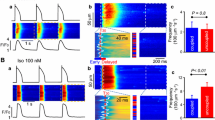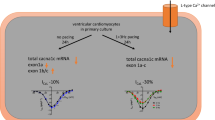Abstract
L-type calcium current (ICa) plays a critical role in excitation–contraction coupling (ECC). Unlike transient outward K+ current (Ito), it is controversial whether ICa transmural gradient exists in left ventricle. Although previous studies have shown some evidences for ICa heterogeneity, the mechanism is still unknown. In this study, the authors recorded ICa from epicardial (EPI) and endocardial (ENDO) myocytes isolated from murine left ventricle using patch-clamp technique. It was found that ICa density was obviously larger in EPI than in ENDO (7.3 ± 0.3 pA/pF vs. 6.2 ± 0.2 pA/pF, at test potential of +10 mV, P < 0.05). The characteristics of ICa showed no difference between these two regions except for the fast inactivation time constants (9.9 ± 0.9 ms in EPI vs. 13.5 ± 0.9 ms in ENDO, at test potential of +10 mV, P < 0.05). In addition, it was explored the molecular mechanism underlying ICa transmural gradient by Western blot. The authors demonstrated that a higher activity of CaMKII in ENDO cells induced more nuclear translocation of p65, a component of nuclear factor-kappa B (NF-kB). Consequently, p65 in ENDO inhibited more transcription of Cav1.2, the main encoding gene for L-type calcium channels (LTCCs). These results reveal a difference in CaMKII/p65 signal pathway between EPI and ENDO that underlies this mechanism of ICa heterogeneity in murine left ventricle.




Similar content being viewed by others
References
Sims C, Reisenweber S, Viswanathan PC et al (2008) Sex, age, and regional differences in L-type calcium current are important determinants of arrhythmia phenotype in rabbit hearts with drug-induced long QT type 2. Circ Res 102(9):e86–e100
Patel SP, Campbell DL (2005) Transient outward potassium current’, Ito’, phenotypes in the mammalian left ventricle: underlying molecular, cellular and biophysical mechanisms. J Physiol 569:7–39
Demolombe S, Marionneau C, Le Bouter S et al (2005) Functional genomics of cardiac ion channel genes. Cardiovasc Res 67:438–447
Xiong W, Tian Y, DiSilvestre D et al (2005) Transmural heterogeneity of Na+–Ca2+exchange: evidence for differential expression in normal and failing hearts. Circ Res 97:207–209
Gao J, Wang W, Cohen IS et al (2005) Transmural gradients in Na/K pump activity and [Na+]i in canine ventricle. Biophys J 89:1700–1709
Liu DW, Antzelevitch C (1995) Characteristics of the delayed rectifier current (IKr and IKs) in canine ventricular epicardial, midmyocardial, and endocardial myocytes. A weaker IKs contributes to the longer action potential of the M cell. Circ Res 76:351–365
Zygmunt AC, Eddlestone GT, Thomas GP et al (2001) Larger late sodium conductance in M cells contributes to electrical heterogeneity in canine ventricle. Am J Physiol 281:H689–H697
Beuckelmann DJ, Nabauer M, Erdmann E (1993) Alterations of K+ currents in isolated human ventricular myocytes from patients with terminal heart failure. Circ Res 73:379–385
Bers DM, Despa S (2006) Cardiac myocytes Ca2+ and Na+ regulation in normal and failing hearts. J Pharmacol Sci 100:315–322
Fabiato A (1983) Calcium-induced release of calcium from the cardiac sarcoplasmic reticulum. Am J Physiol 245:C1–C14
Jurkat-Rott K, Lehmann-Horn F (2004) The impact of splice isoforms on voltage-gated calcium channel alpha1 subunits. J Physiol 554:609–619
Fuller-Bicer GA, Varadi G, Koch SE et al (2009) Targeted disruption of the voltage-dependent calcium channel alpha2/delta-1-subunit. Am J Physiol Heart Circ Physiol 297:H117–H124
Hullin R, Singer-Lahat D, Freichel M et al (1992) Calcium channel beta subunit heterogeneity: functional expression of cloned cDNA from heart, aorta and brain. EMBO 11:885–890
Wang HS, Cohen IS (2003) Calcium channel heterogeneity in canine left ventricular myocytes. J Physiol 547:825–833
Pham TV, Robinson RB, Danilo P Jr et al (2002) Effects of gonadal steroids on gender-related differences in transmural dispersion of L-type calcium current. Cardiovasc Res 53:752–762
Bryant SM, Shipsey SJ, Hart G (1997) Regional differences in electrical and mechanical properties of myocytes from guinea-pig hearts with mild left ventricular hypertrophy. Cardiovasc Res 35:315–323
Kimura S, Bassett AL, Furukawa T et al (1991) Differences in the effect of metabolic inhibition on action potentials and calcium currents in endocardial and epicardial cells. Circulation 84:768–777
Bryant SM, Shipsey SJ, Hart G (1999) Normal regional distribution of membrane current density in rat left ventricle is altered in catecholamine-induced hypertrophy. Cardiovasc Res 42:391–401
Kim N, Cannell MB, Hunter PJ (2010) Changes in the calcium current among different transmural regions contributes to action potential heterogeneity in rat heart. Prog Biophys Mol Biol 103:28–34
Dilly KW, Rossow CF, Votaw VS et al (2006) Mechanisms underlying variations in excitation–contraction coupling across the mouse left ventricular free wall. J Physiol 572:227–241
Wang Y, Tandan S, Cheng J (2008) CaMKII-dependent remodeling of Ca2+ current in pressure-overload heart failure. J Biol Chem 283:25524–25532
Xu L, Lai D, Cheng J et al (2010) Alterations of L-type calcium current and cardiac function in CaMKII delta knockout mice. Circ Res 107:398–407
Ishiguro K, Green T, Rapley J et al (2006) Ca2+/calmodulin dependent protein kinase II is a modulator of CARMA1-mediated NF-kappaB activation. Mol Cell Biol 26:5497–5508
Shi XZ, Pazdrak K, Saada N et al (2005) Negative transcriptional regulation of human colonic smooth muscle Cav1.2 channels by p50 and p65 subunits of nuclear factor-kappaB. Gastroenterology 129:1518–1532
Rossow CF, Minami E, Chase EG et al (2004) NFATc3-induced reductions in voltage-gated K+ currents after myocardial infarction. Circ Res 94:1340–1350
Findlay I, Suzuki S, Murakami S (2008) Physiological modulation of voltage-dependent inactivation in the cardiac muscle L-type calcium channel: a modelling study. Prog Biophys Mol Biol 96:482–498
Yuan W, Bers DM (1994) Ca-dependent facilitation of cardiac Ca current is due to Ca-calmodulin-dependent protein kinase. Am J Physiol 267:H982–H993
Findlay I (2002) Voltage- and cation-dependent inactivation of L-type Ca2+ channel currents in guinea-pig ventricular myocytes. J Physiol 541:731–740
Huke S, Bers DM (2007) Temporal dissociation of frequency-dependent acceleration of relaxation and protein phosphorylation by CaMKII. J Mol Cell Cardiol 42:590–599
Akar FG (2010) Left ventricular repolarization heterogeneity as an arrhythmic substrate in heart failure. Minerva Cardioangiol 58:205–212
Yue L, Feng J, Gaspo R (1997) Ionic remodeling underlying action potential changes in a canine model of atrial fibrillation. Circ Res 81:512–525
Rossow CF, Dilly KW, Santana LF (2006) Differential calcineurin/NFATc3 activity contributes to the Ito transmural gradient in the mouse heart. Circ Res 98:1306–1313
Maier LS, Bers DM (2002) Calcium, calmodulin, and calcium-calmodulin kinase II: heartbeat to heartbeat and beyond. J Mol Cell Cardiol 34:919–939
Santana LF, Chase EG, Votaw VS et al (2002) Functional coupling of calcineurin and protein kinase A in mouse ventricular myocytes. J Physiol 544:57–69
Benitah JP, Alvarez JL, Gómez AM (2010) L-type Ca (2+) current in ventricular cardiomyocytes. J Mol Cell Cardiol 48:26–36
Bányász T, Fülöp L, Magyar J (2003) Endocardial versus epicardial differences in L-type calcium current in canine ventricular myocytes studied by action potential voltage clamp. Cardiovasc Res 58:66–75
Acknowledgment
This study was supported by Eleventh Five-year Priority Projects of Hubei Science and Technology Department, China (no. 2006A301A04) and the National 211 Priority Projects of Wuhan University.
Author information
Authors and Affiliations
Corresponding author
Rights and permissions
About this article
Cite this article
Xu, L., Li, XY., Liu, Y. et al. The mechanisms underlying ICa heterogeneity across murine left ventricle. Mol Cell Biochem 352, 239–246 (2011). https://doi.org/10.1007/s11010-011-0759-8
Received:
Accepted:
Published:
Issue Date:
DOI: https://doi.org/10.1007/s11010-011-0759-8




